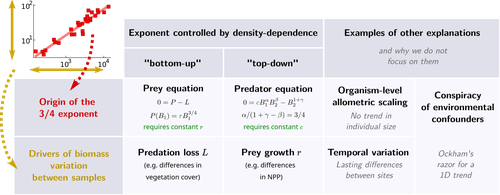PAWAR Samraat
- Life Sciences, Imperial College London, Ascot, United Kingdom
- Allometry, Biological invasions, Climate change, Community ecology, Competition, Eco-evolutionary dynamics, Ecosystem functioning, Evolutionary ecology, Food webs, Foraging, Interaction networks, Microbial ecology & microbiology, Physiology, Theoretical ecology, Thermal ecology
- recommender
Recommendation: 1
Review: 1
Recommendation: 1
Interplay between the paradox of enrichment and nutrient cycling in food webs
New insights into the role of nutrient cycling in food web dynamics
Recommended by Samraat Pawar based on reviews by Jean-François Arnoldi, Wojciech Uszko and 1 anonymous reviewerUnderstanding the factors that govern the relationship between structure, stability and functioning of food webs has been a central problem in ecology for many decades. Historically, apart from microbial and soil food webs, the role of nutrient cycling has largely been ignored in theoretical and empirical food web studies. A prime example of this is the widespread use of Lotka-Volterra type models in theoretical studies; these models per se are not designed to capture the effect of nutrients being released back into the system by interacting populations. Thus overall, we still lack a general understanding of how nutrient cycling affects food web dynamics.
A new study by Quévreux, Barot and Thébault [1] tackles this problem by building a new food web model. This model features some important biological details: trophic interactions and vital rates constrained by species' body masses (using Ecological Metabolic Theory), adaptive foraging, and stoichiometric rules to ensure meaningful conversion between carbon and nutrient flows. The authors analyze the model through detailed simulations combined with thorough sensitivity analyses of model assumptions and parametrizations (including of allometric scaling relationships). I am happy to recommend this preprint because of the novelty of the work and it's technical quality.
The study yields interesting and novel findings. Overall, nutrient cycling does have a strong effect on community dynamics. Nutrient recycling is driven mostly by consumers at low mineral nutrient inputs, and by primary producers at high inputs. The extra nutrients made available through recycling increases species' persistence at low nutrient input levels, but decreases persistence at higher input levels by increasing population oscillations (a new, nuanced perspective on the classical "paradox of enrichment"). Also, for the same level of nutrient input, food webs with nutrient recycling show more fluctuations in primary producer biomass (and less at higher trophic levels) than those without recycling, with this effect weakening in more complex food webs.
Overall, these results provide new insights, suggesting that nutrient cycling may enhance the positive effects of species richness on ecosystem stability, and point at interesting new directions for future theoretical and empirical studies.
References
[1] Quévreux, P., Barot, S. and E. Thébault (2020) Interplay between the paradox of enrichment and nutrient cycling in food webs. bioRxiv, 276592, ver. 7 peer-reviewed and recommended by PCI Ecology. doi: 10.1101/276592
Review: 1

General mechanisms for a top-down origin of the predator-prey power law
Rethinking Biomass Scaling in Predators-Preys ecosystems
Recommended by Samir Simon Suweis based on reviews by Samraat Pawar and 1 anonymous reviewerThe study titled “General mechanisms for a top-down origin of the predator-prey power law” provides a fresh perspective on the classic predator-prey biomass relationship often observed in ecological communities. Traditionally, predator-prey dynamics have been examined through a bottom-up lens, where prey biomass and energy availability dictate predator populations. However, this study, which instead explores the possibility of a top-down origin for predator-prey power laws, offers a new dimension to our understanding of ecosystem regulation and raises questions about how predator-driven interactions might influence biomass scaling laws independently of prey abundance.
Ecologists have long noted that ecosystems often exhibit sublinear scaling between predator and prey biomasses. This pattern implies that predator biomass does not increase proportionally with prey biomass but at a slower rate, leading to a power-law relationship. Traditional explanations, such as those discussed by Peters (1983) and McGill (2006), have linked this to bottom-up processes, suggesting that increases in prey availability support, but do not fully translate to, larger predator populations due to energy losses in the trophic cascade. However, these explanations assume prey abundance as the principal driver. This new work raises an intriguing question: could density-dependent predator interactions, such as competition and interference, be equally or more important in creating this observed power law?
The authors hypothesized that density-dependent predator interactions might independently control predator biomass, even when prey is abundant. To test this, they combined predator and prey biomass dynamics equation based on a modified Lotka-Volterra model with agent-based models (ABMs) on a spatial grid, simulating predator-prey populations under varying environmental gradients and density-dependent conditions. These models allowed them to incorporate predator-specific factors, such as intraspecific competition (predator self-regulation) and predation interference, offering a quantitative framework to observe whether these top-down dynamics could indeed explain the observed biomass scaling independently of prey population changes.
Their results show that density-dependent predator dynamics, particularly at high predator densities, can yield sublinear scaling in predator-prey biomass relationships. This aligns well with empirical data, such as African mammalian ecosystems where predators seem to self-regulate under high prey availability by competing amongst themselves rather than expanding in direct proportion to prey biomass. Such findings support a shift from bottom-up perspectives to a model where top-down processes drive population regulation and biomass scaling.
I think that the work by Mazzarisi and collaborators (2024) offers a thought-provoking twist on predator-prey dynamics and suggests that our traditional frameworks may benefit from a broader, more predator-centered focus.
References
1. Onofrio Mazzarisi, Matthieu Barbier, Matteo Smerlak (2024) General mechanisms for a top-down origin of the predator-prey power law. bioRxiv, ver.2 peer-reviewed and recommended by PCI Ecology https://doi.org/10.1101/2024.04.04.588057
2. Peters, R. H. (1986). The ecological implications of body size (Vol. 2). Cambridge university press.
3. McGill, B. J. (2006). “A renaissance in the study of abundance.” Science, 314(5801), 770-772. https://doi.org/10.1126/science.1134920